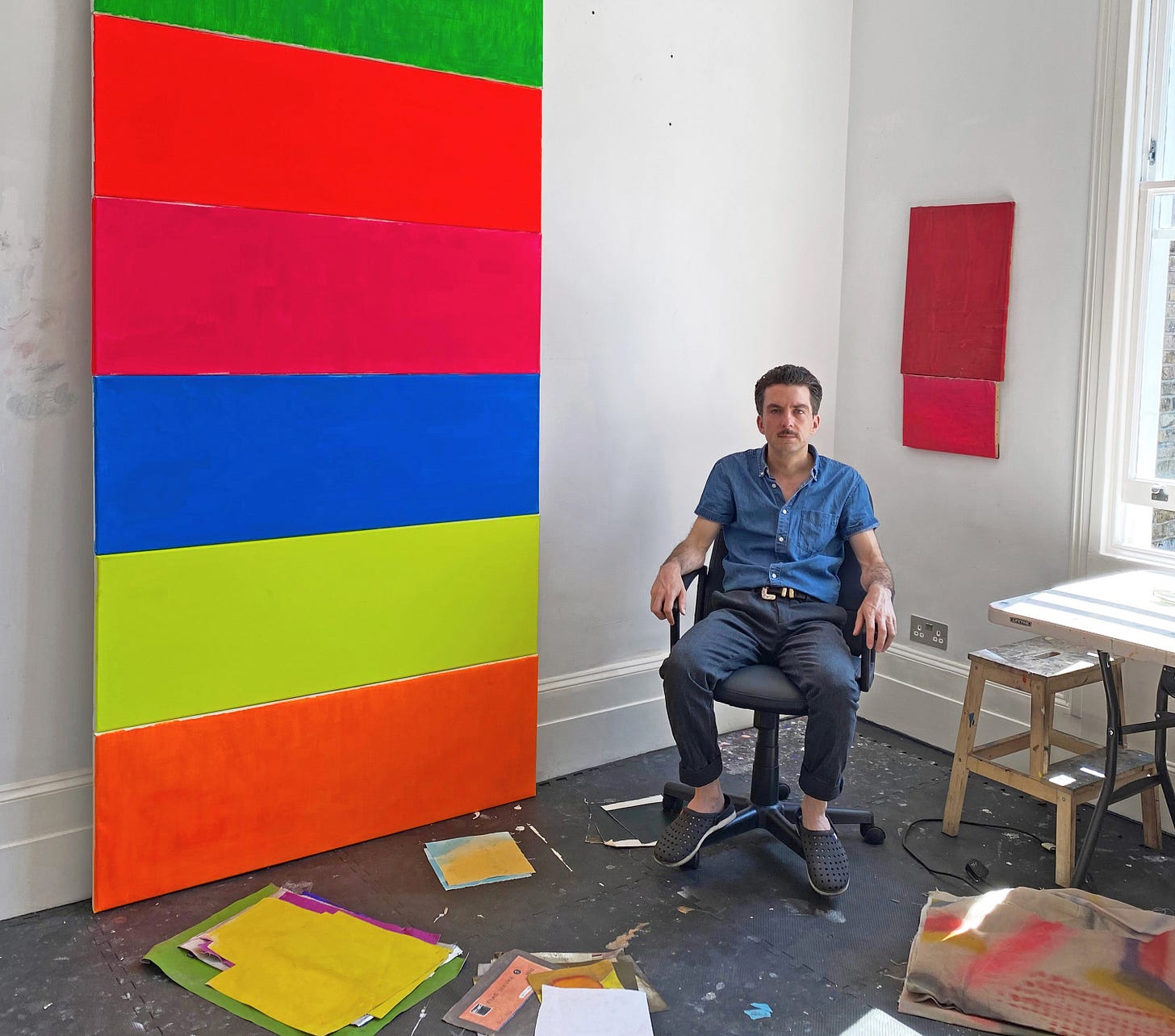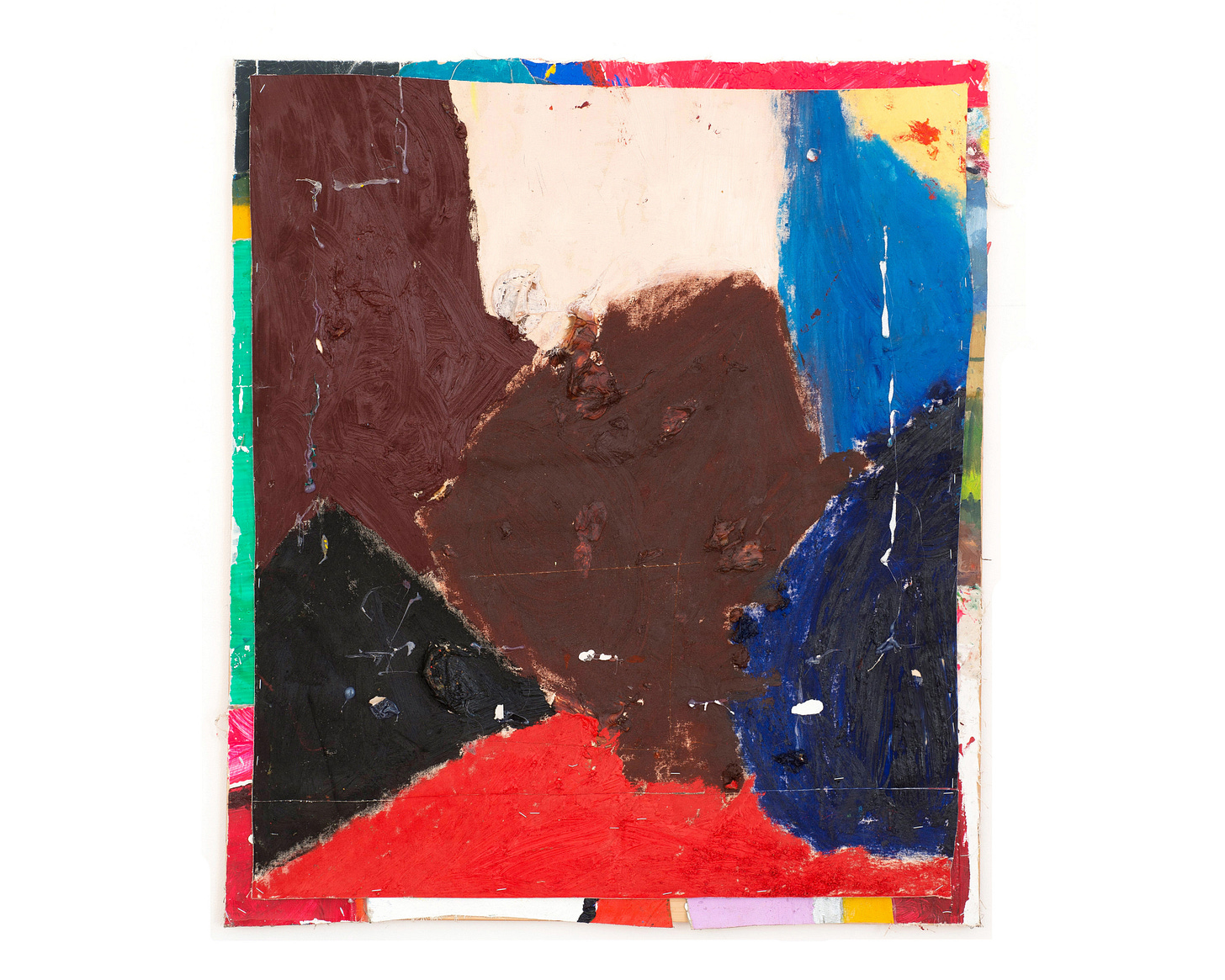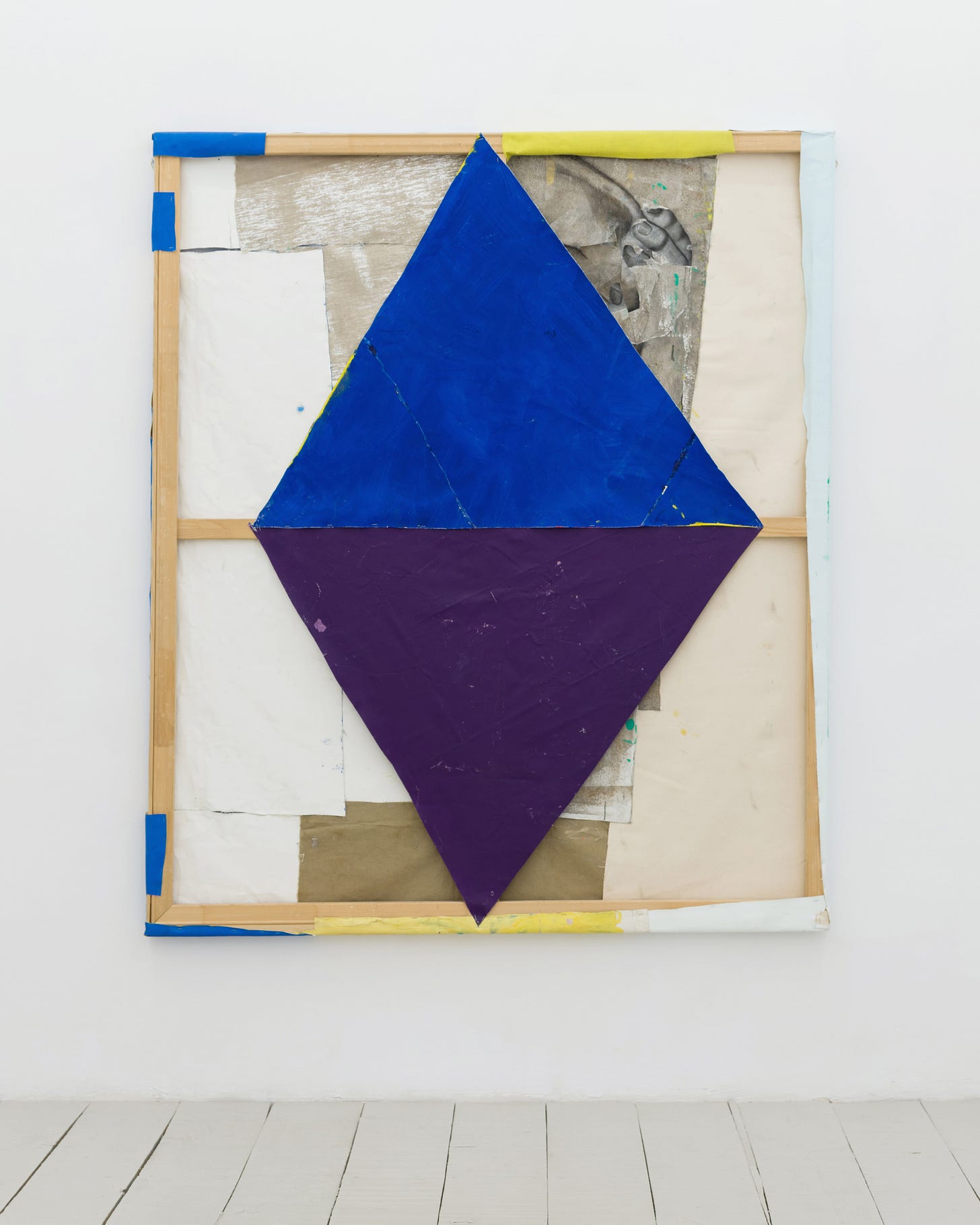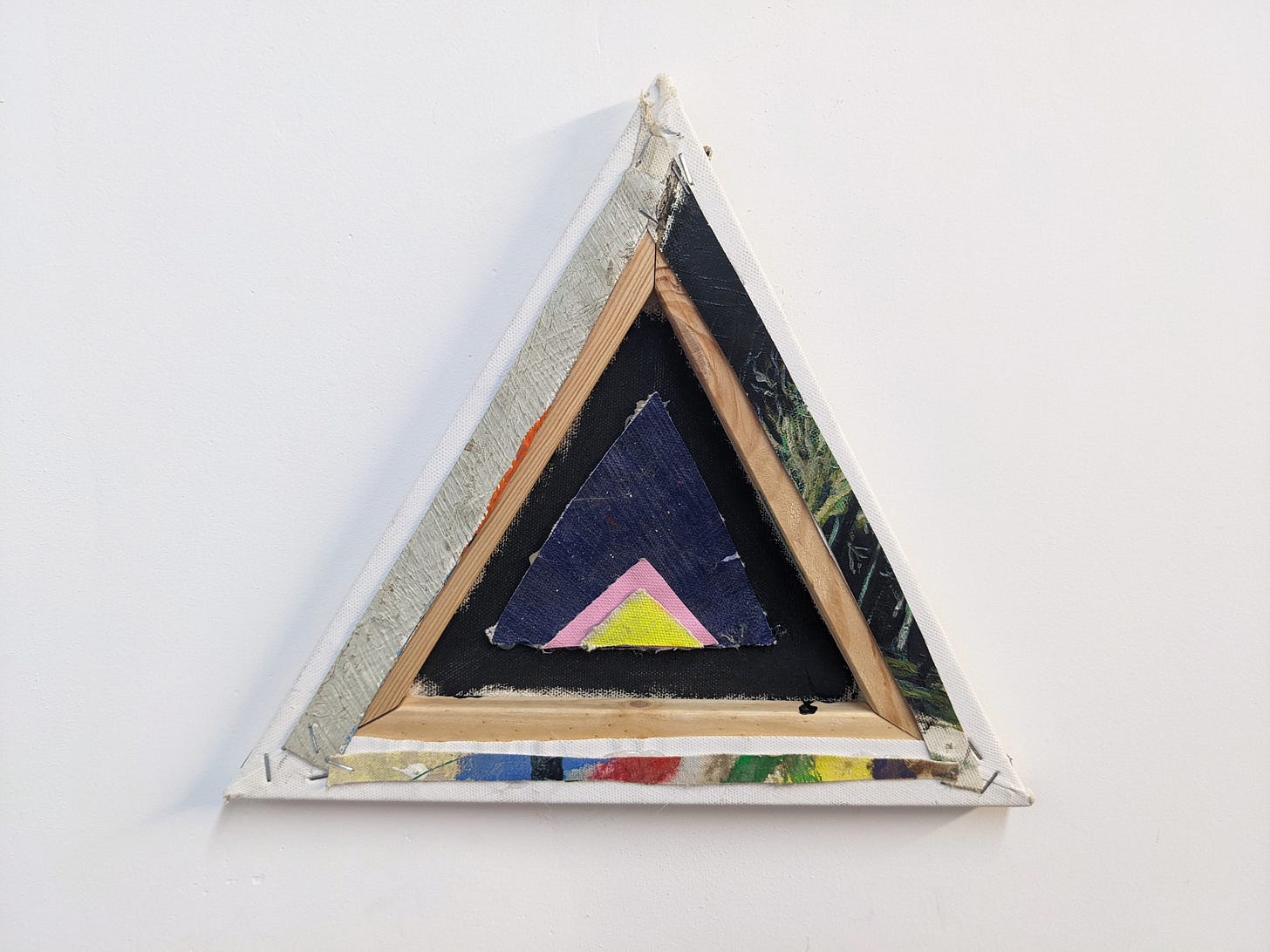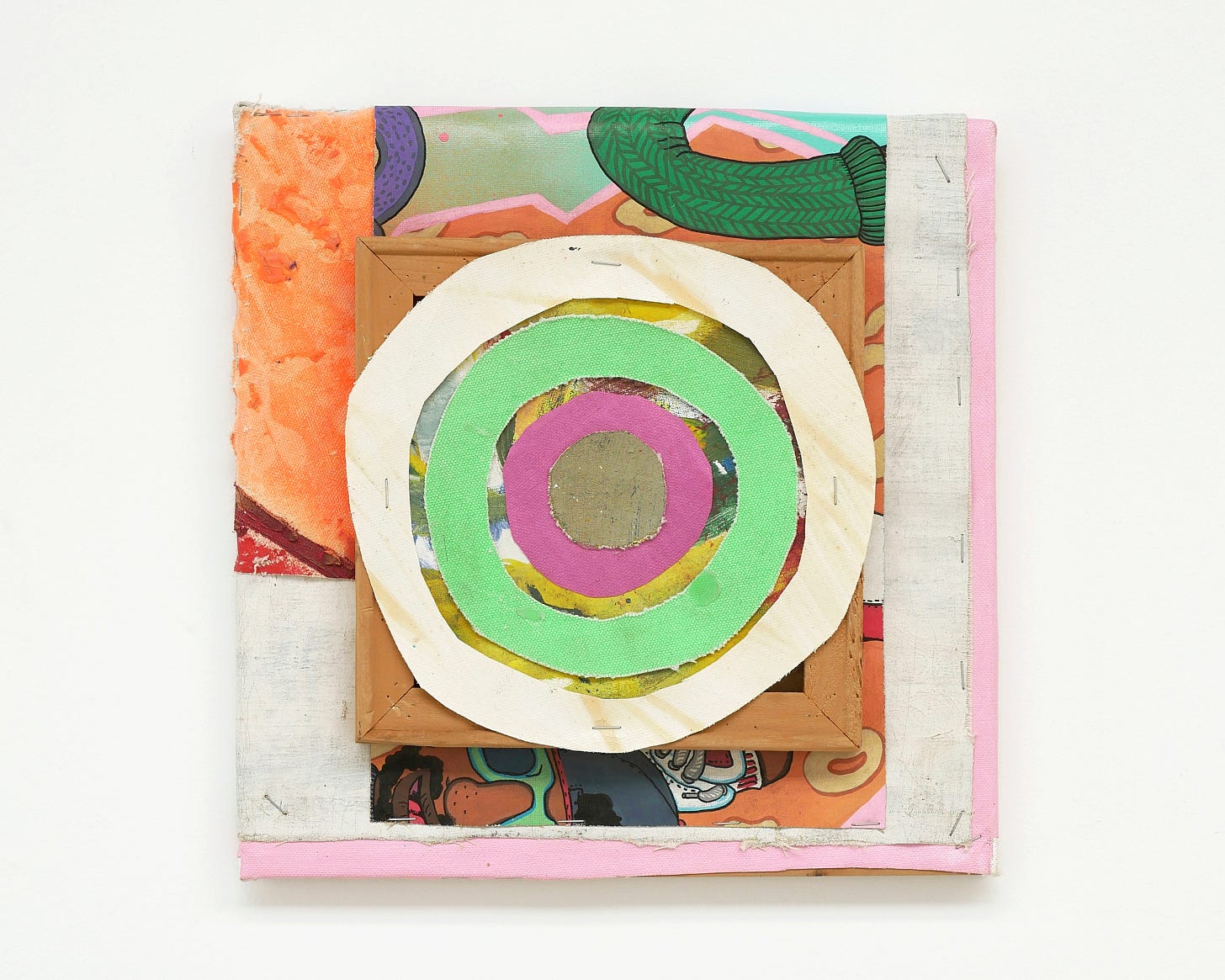Bobby Dowler Embraces Wrong Turns in Painting
When I first saw Bobby Dowler’s paintings online I thought they were typical hard-edged geometric abstraction. You know, perfectly straight lines, uniform blocks of pristine paint, as if made by a robot. I failed to notice the human touch, the cobbled togetherness, the rough-around-the-edges quality that makes them so alluring on closer inspection.
I was lucky enough to catch Bobby’s work in person at a recent group show at Haricot Gallery. His works surprised me with their painterly marks and the ramshackle way they had been constructed, often with the stretchers themselves becoming part of the work. I loved the way he softened the geometry with a more rugged finish, like a rigid structure undermined by human error. It was also a happy reminder that I like surprises in art, rather than what you see is what you get.
I reached out to Bobby, a British-Irish artist currently living in Paris, to ask him about his unique approach to painting, the importance of wrong turns, and respecting weirdness.
Hi Bobby. Your recent solo show at Galería Alegría in Barcelona looked great. What can you tell me about the work you showed there?
Thanks! Well, there are four new multi-part ‘painting-objects’ on display and they unexpectedly came together at the last hour. But only after months of intense experimentation. The short story is that I had been building up material to use and I had been testing out a multi-part installation idea based on an outcome I had stumbled upon earlier.
On first glance your work is quite geometric but it feels like you’re not afraid of wonky lines and marks - are you searching for a loose quality to balance out the formal parts?
Maybe on an unconscious level. I work intuitively, stumbling around like a fool until I’m hooked onto an invisible like-current, then I become more of a conduit, an intermediary between known and unknown worlds. I’ve developed a casual interest in sacred geometry, triangles, pyramids and maths. I’m perhaps bending the rigidity of geometry to rein in disorder.
I love seeing parts of the stretchers and underlying construction. It’s all very tactile and beyond mere paint on canvas. How would you describe your approach to painting?
Thanks! All these marks are incidental and come about through process and not with any intentionality to make a design. They’re more like cuts, bruises or blunt trauma that an object or being acquires over time - through neglect, misadventure, adventure or just lifespan. A ‘painting-object’ condition report can be quite complex, haha.
I think of ‘painting’ as a verb and a noun. The action of painting and the object of its result. Naming them ‘painting-object’ is, for better or worse, quite literally based upon this premise.
My approach to painting: don’t be a heavy horse - work calmly, joyously, recklessly on whatever is at hand (I may have plagiarised that from a dead writer), and to respect weirdness!
A lot of what you do seems to be about bringing different parts together, almost like collage - is that something you have in mind?
Yes, that’s right. I’m interested in the drama of necessity and what I can make without getting too sucked in by the consumer culture within which I produce, right? Bringing material and fixing it together is one thing and always a valid aspect of subject matter for me.
The questions that dominate my mind are: What is working and why? What's not working and why? What actions can I take to overcome this? Quite simplistic but it works for me.
Your colours are really vibrant for the most part - how do you think about those choices?
This may sound odd but I don't spend much time thinking about colour - that might paradoxically explain the vibrancy! I do try to avoid overusing any one shade. I use blocks of colour in the same way that I use geometry - to help find a form. I might introduce a shop-bought paint once in a while because I’m stuck and haven’t got any painted canvas that colour. I do reflect upon what I’m doing afterwards but it’s more like action without thinking and then follow wherever this may lead.
Paint and colour are materials and tools to me - they can get the motor rolling - then it's not so much about them anymore, and more about following the experience that’s been activated.
What can you tell me about the importance of wrong turns in your work?
Being wrong means I’m out of my depth or on the edge of my field of knowledge. That’s the optimal place for learning. To me, wrong turns are almost intuitive because that's how I wake up my senses and enter unknown territory. I’m quite clumsy and tend to jump straight in without thinking. Then it’s a case of the long way round if I want to understand - reverse engineering.
Wrong turns might be a sign that you’re daydreaming. There's not enough to learn from repeating what has already been integrated unless I’ve forgotten it and then this is more of a revision. I respect wrong turns or what might feel at first like a mistake - the mistake might be the solution that guides me towards a new pathway. Was the wrong turn actually the best path forward?
From what I gather you’ve lived in a bunch of different European cities - has that helped your work grow in different ways?
I think the psychological impact of living abroad as a foreigner and its influence on my work's growth is inevitable. The bombing of my senses through new environmental factors, culture, people, language etc, has its effect on the psyche, but I can’t be that objective about my own experience as I’m still inside it.
I've been sourcing the majority of my material and completing most of my artwork in and around Paris. The orphaned paintings and second-hand painting materials, which have mostly been acquired by me from here too.
The blank canvases and wood-stretcher-frames that were originally acquired by aspiring painters all capture the touch of the individual or an industrial machine; the images contain the changing schools of painterly thought and fashions, snippets of a time and place. These works were eventually left to languish. By utilising abandoned paintings as my starting point I feel that I give myself a critical distance from which to perceive the commercial culture within which I create.
What are you interested in outside of art? And how important is it to step away from your work sometimes?
I like tutoring or mentoring art students but I guess that's not outside the realm of art. I have a son and fiancee so stepping away from my work at the end of each day and most weekends is routine. These responsibilities are healthy and keep me grounded though don’t leave me too much free time outside of the studio. But that suits me because I’m a curious personality - too curious and need to constantly rein it in. I can bounce around different interests like a pinball in a machine but broadly I’m interested in people, ideas, music, stories, exploring and making stuff.
In a word, what makes a great painting?
Magic.
Follow Bobby on Instagram: @bobbydowler
Things on Our Radar This Week
The ‘Journey Into the Unknown’ group show of abstract painters at Haricot Gallery (opens 17 May)
RIP Frank Stella, one of the most influential US abstract artists of the 20th century
The Art Newspaper asks if artist-run shows have lost their power in the age of biennials
Mega gallery David Zwirner is opening what will be its largest gallery in LA (with parking spaces!)
A James Kalm tour of Amy Sillman’s fantastic-looking show at Gladstone Gallery in NYC
Thanks for reading, see you next week!
Oliver & Kezia xx
Palette Talk is free and we hope to grow with your support. If you’ve enjoyed reading, drop us a donation via PayPal…




